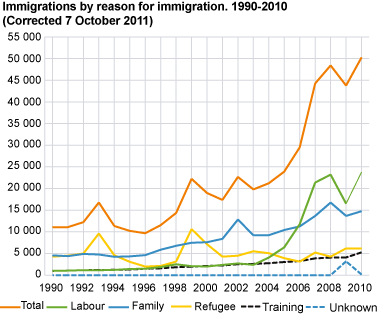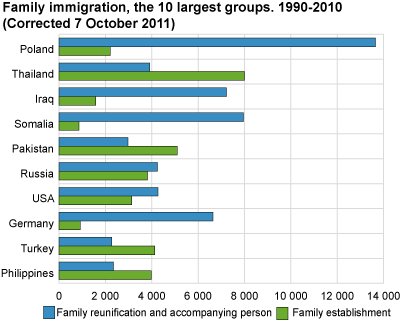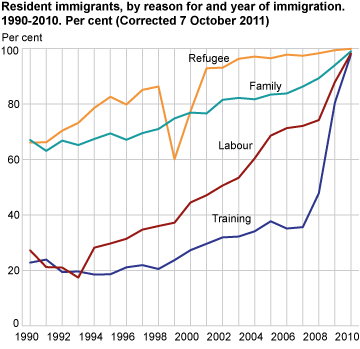Content
Published:
This is an archived release.
High labour immigration [Corrected 7 October 2011]
In 2010, 50 000 immigrants with non-Nordic citizenship immigrated to Norway for the first time. Labour, education and family immigration increased from 2009 to 2010. The number of immigrations due to flight remained stable.
|
The article that was published on 25 August 2011 contained some errors in the breakdown by reason for immigration for immigrants from EEA countries. A number of immigrants with labour as the reason for immigration should have had family or education as the reason. The corrected article, figures and tables were published on 7 October 2011. |
Two thirds of all immigrants in 2010 came from EU/EEA countries, USA, Canada, Australia and New Zealand. As in the previous five years, labour immigration was the most common reason for immigration among non-Nordic citizens.
Most from Poland
In 2010 there were 23 800 persons from non-Nordic countries that immigrated due to labour, the highest number ever registered. Out of those who came to Norway in 2010 due to labour, immigrants from Poland made up the largest group. After Poland came Lithuania, Latvia and Germany.
During 2010, there was an increase in the number of people registered as family immigrants compared with 2009. In total, 14 800 came due to family reasons and 38 per cent of these came from the new EU countries in Eastern Europe.
There were fewer families who immigrated to a person with a refugee background in 2010 compared with the year before. In 2010, 1 960 people came to Norway on that basis, while the corresponding figure for 2009 was 2 550.
Flight is stable and education is increasing
A total of 6 200 persons came to Norway due to flight. Most of them came from Eritrea, Somalia and Afghanistan. They made up only 12 per cent of the non-Nordic immigrants in 2010.
A total of 5 300 of those who immigrated in 2010 did so because of education. This was an increase of 1 200 since 2009 and the highest number ever registered. There were relatively many immigrants from Philippines, China, Russia and USA in this group. The number of registered students from Philippines is high because the au pair permit is also considered to be a type of education permission.
3 out of 4 still here
More than 470 600 persons with non-Nordic citizenship immigrated to Norway between 1990 and 2010. Three out of 4 still lived in the country at the beginning of 2011. Among those who immigrated due to flight and family since 1990, more than 80 per cent still lived in Norway on 1 January 2011. The corresponding percentages for those who immigrated due to labour and those who immigrated for education were 72 and 42 per cent respectively.
|
Statistics on reason for immigration include all immigrants with non-Nordic citizenship that immigrated to Norway between 1990 and 2010. Employees on short-term stays (less than six months) are not registered as residents in the population register and thus not included in the statistics. Persons adopted from abroad are not included in the statistics because they are not considered to be immigrants. The most important data sources are the Directorate of Taxes’ Central Population Register (CPR) and the Norwegian Directorate of Immigration’s Aliens Register (UDB). |
Tables:
- Table 1 Immigrations by reason for immigration, year of immigration and citizenship. 1990-2010 (Corrected 7 October 2011)
- Table 2 Immigrations by reason for immigration and citizenship. 1990-2010 (Corrected 7 October 2011)
- Table 3 Immigrations by reason for immigration and citizenship. 2010 (Corrected 7 October 2011)
- Table 4 Immigrations by reason for immigration, year of immigration and immigrants still resident on 1 January 2011. 1990-2010. Absolute figures and per cent (Corrected 7 October 2011)
- Table 5 Immigrants with family as reason for immigration, by type of family unification, immigrant category of reference person and citizenship. 2010 and 1990-2010 (Corrected 7 October 2011)
- Table 6 Family immigrations , by type of family unification, immigration category of reference person, year of immigration and citizenship. 2010 (Corrected 7 October 2011)
- Table 7 Immigrations by reason for immigration, sex and age. 1990-2010 (Corrected 7 October 2011)
Contact
-
Statistics Norway's Information Centre
E-mail: informasjon@ssb.no
tel.: (+47) 21 09 46 42
-
Oppdrag innvandring
E-mail: oppdraginnvandring@ssb.no
-
Mads Ivar Kirkeberg
E-mail: mads.ivar.kirkeberg@ssb.no
tel.: (+47) 40 81 13 21
-
Frøydis Strøm
E-mail: froydis.strom@ssb.no
tel.: (+47) 40 81 13 17



